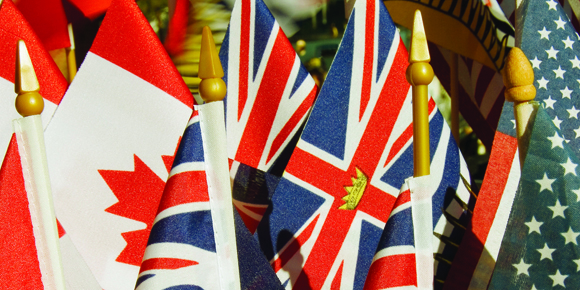Canadian English is both British and American in style. Canada was overseen by a long series of British governors-general so could not hope to escape British influence. As well, for years, most immigrants came from Scotland and England.
But our proximity to the U.S. always meant we absorbed much of the American way of speaking.
One marked influence on Canadian English arose from the 1776-1783 influx of United Empire Loyalists — some 50,000 at that time and another 80,000 after 1791. By 1812, about 80 per cent of Upper Canada’s population originated in the U.S.
Many other factors left their marks on Canadian English. French, naturally, not only contributed much vocabulary, but has played a key role in defining such important areas as geography, politics, and society.
The fur trade also made a huge impact on Canadian English. In fact, two uniquely Canadian languages evolved from this trade — Bungee, now considered obsolete, and Mitchif. Both languages grew from a mixture of indigenous and European tongues. The Hudson’s Bay Company impacted both these languages as well as Canadian English.
The Yukon Gold Rush brought prospectors from far and wide, and they too influenced our language.
Separatism added not only vocabulary but also affected the meanings of many existent words.
When we speak of Canadian English, we’re speaking of a mishmash of British English, American English, and words lifted both from French and from immigrant tongues, as well as from indigenous languages.
So, how does this work?
British spellings are the norm in textbooks and in most print media, but vocabulary and pronunciation often diverge from British style.
Like our American neighbours, Canadians enunciate the letter “R” in word endings and when the R precedes a consonant. We pronounce that R in such words as differ, father, and further.
The word lever, other than that final R, receives the British pronunciation—LEEver, not the American LEVer. And we don’t say out as if it started with an “A” (aout). This Canadian pronunciation has led Americans to accuse us of saying oot and aboot
Curiously, not only do we borrow French words, we also borrow French meanings then transfer them to existing English vocabulary, e.g., modalities (details).
We do have many uniquely Canadian words, often borrowed from First Nations languages — kayak, mukluk, parka, saskatoon and muskeg, to name a few.
Other Candianisms involve new usage for an old word. Only on the Canadian prairies is a bluff a grove of trees (1744). Elsewhere, it’s a cliff, riverbank or promontory. Evidently, when settlers crossing the prairies noticed a shadowy something in the distance, they’d assume it to be a rise in the flat terrain. “Look!” they’d exclaim. “A bluff!” And upon reaching it, they’d find only trees.
Nuisance grounds and eavestrough are other strictly Canadian terms.
A few Canadianisms have entered Standard English — white-out, igloo, separatist, toboggan, tuque and pemmican are examples.
Stampede (American-Spanish) when employed to mean “rodeo,” arose in Canada.
Oxford says English Canadians developed needed vocabulary by borrowing from French and indigenous languages, and by adopting traditional English words. But that assessment ignores the influence of our next-door neighbours.



